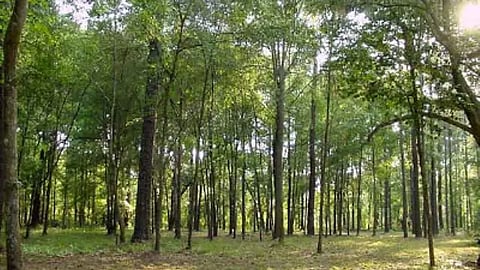
- Home
- Live Blog
- Breaking News
- Top Headlines
- Cities
- NE News
- Sentinel Media
- Sports
- Education
- Jobs

The straying of leopards in residential areas of Guwahati and the recurrence of landslides on the hills are ringing the alarm bells on the rapid loss of balance between the built environment of human settlements and nature in the city. Ironically, the failure on the part of the forest authorities and administration to curb encroachment of the city hills prompted the National Green Tribunals (NGT) to intervene and direct the state government to undertake expeditious steps for removal of the encroachments in the Reserved Forests (RFs) of Kamrup (Metropolitan) district. The NGT directive has opened a window of opportunity for the authorities concerned to rectify the past mistakes and restore the lost ecology for conservation of rich biological diversity in 12 reserved forests in the metropolitan district. An affidavit submitted by the Principal Chief Conservator of Forest and Head of Forest Force, Assam, shows that out of 28,380 hectares of RF areas in the district, about 4,240 hectares are under encroachment. The encroachment is in eight RFs: South Kalapahar RF, Fatasil RF, Hengrabari RF, Gotanagar RF, Garbhanga RF, Marakdola RF, West Apricola RF and Matapahar RF. The NGT observes that though certain encroachment drives are stated to have been carried out during 2022 and 2023-24, the land which has been recovered from the encroachers comprises a minuscule percentage of the total land under encroachment, which renders such anti-encroachment drives completely futile. The NGT has set December 31, 2026, for compliance and filing of the Action Taken Report, which implies that the Forest Department has a window of more than a year and a half to remove the encroachment from the RF. Though the government has no legal obligation to rehabilitate encroachers in RF areas, as such encroachments are illegal, construction of affordable housing within the city can be effective in preventing re-encroachment by evicted households. Encroachers getting electricity connections despite the Forest Department’s admission of the encroachment of RF areas is baffling, as the Assam Power Distribution Company Limited cannot provide power connections without the No Objection Certificate issued by the Forest Department. The Forest Department requested the APDCL to disconnect power connections provided to encroachers in RF areas. The APDCL clarifying the status of power connections of encroachers in RF areas is critical to disincentivise encroachment on the city’s forest areas. The affidavit submitted before the NGT shows that nearly 15 % of the total RF areas in the city have already been encroached. If the process is not reversed through removal of the encroachment, the percentage of encroached area increasing to 50% or more is just a matter of time. One can imagine the wanton loss of biodiversity in the city that has already occurred and over the next decade on account of failure to remove and prevent encroachment and destruction of forest. Encroachment of the city hills has aggravated the problem of waterlogging in the foothill areas, with rapid loss of topsoil and clearing of the green cover resulting in silt and debris clogging the drainage network in the plains. When more areas of RF are cleared due to encroachment, a similar problem will be accompanied by a rise in the incidents of human-wildlife conflict in the city. Wide-ranging flora and fauna found in the city’s RF play a crucial role in maintaining the fine balance between nature and humans, with animals, birds, and insects in a forest facilitating conservation of rich plant diversity by facilitating pollination, while survival and growth of plants provide food to animals and maintain the ecoservice systems such as conservation of water and feeding the water sources used by people living in forest fringe areas. A capital city like Guwahati, which is considered the gateway to the Northeast region, attracts people from all over the region to come and settle for jobs, education and livelihoods. Housing needs of the migrant population have remained unaddressed as the inflating land market coupled with expensive housing solutions like multi-storeyed apartments continues to be unaffordable to a large section of middle- and low-income people. Land use planning incorporated in the master plan for the city has underlined the importance of conservation of the city forest areas and wetlands, but due to an inadequate number of low-cost and affordable housing, a large section of migrant families encroached upon the city’s hills and RF areas without caring little about the cascading impact of loss of rich biodiversity in the forest on the city. Raising awareness among middle- and low-income migrant populations about the importance of conservation of biodiversity in the city for sustainable living will encourage them to move the government to expeditiously undertake mega multi-storey housing projects for addressing their accommodation needs. Failure to remove and curb encroachment in RF areas and non-forest hilly areas will also pose a huge obstacle in the efforts to address the aggravating problem of artificial floods and severe landslides in the city.